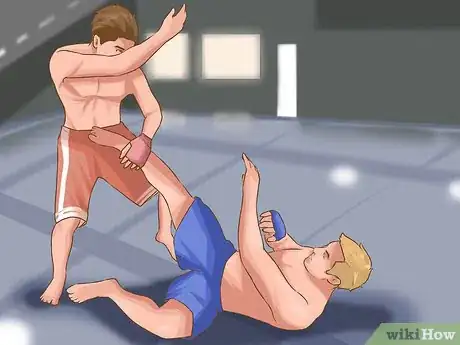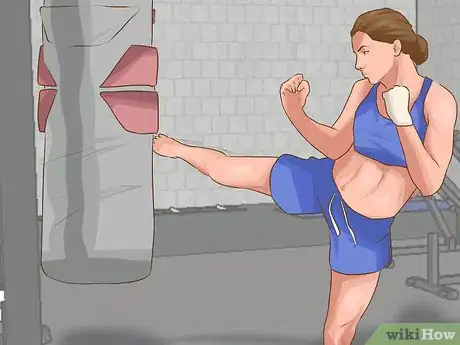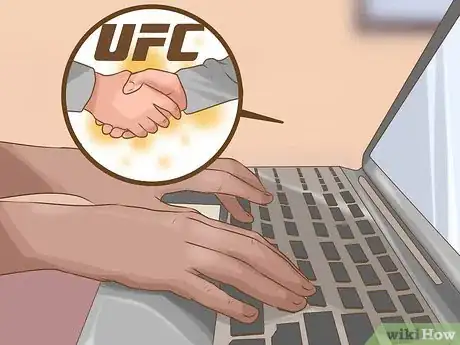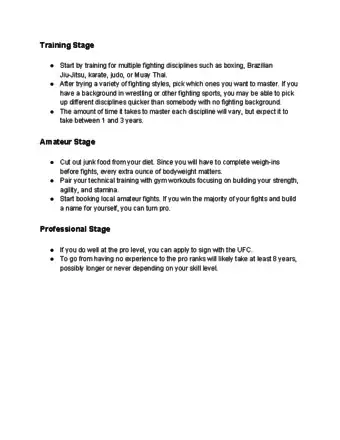This article was co-authored by Derrek Hofrichter. Derrek Hofrichter is a Self Defense Specialist and the Founder of EVKM Self Defense & Fitness in Tempe, Arizona. Derrek specializes in Krav Maga, Personal Safety, and Boxing. Derrek is a Krav Maga Third Degree Black Belt, a Senior Certified Krav Maga Instructor, and a Krav Maga Alliance Executive Board, and Training Team Member. EVKM Self Defense & Fitness was named the 2014 Krav Maga Alliance School of the Year and the 2017 Best Gym/Workout Studio in Phoenix. Derrek was named as one of the top 30 Health and Fitness Leaders in Arizona under the age of 40 by The Arizona Republic and azcentral.com in 2018. He also holds a BA in Government Public Policy from Patrick Henry College.
There are 7 references cited in this article, which can be found at the bottom of the page.
wikiHow marks an article as reader-approved once it receives enough positive feedback. This article received 19 testimonials and 100% of readers who voted found it helpful, earning it our reader-approved status.
This article has been viewed 228,426 times.
Do you want to join the ranks of Randy Couture, Quinton "Rampage" Jackson, and Anderson Silva in becoming an Ultimate Fighter? With the proper guidance and background, you can learn to become the kind of well-rounded athletic competitor that the UFC is looking for. Learn to fight, get experience, and figure out how to go pro. See Step 1 for more information.
Steps
Learning to Fight
-
1Get in shape. Ultimate fighting, or mixed martial arts, is a test of aerobic endurance, strength, agility, and willpower. You have to be an all-around great athlete to be an ultimate fighter, so if it's your ambition to jump into the cage, you need to get in shape.
-
1
- Build muscle and lose fat, rather than attempting to diet and lose lots of weight. You want to build bulk and be strong. Developing a healthy lifting routine and aerobic routine to get into good fighting shape will make transitioning into training much easier.
- If you don't have the time to get to the gym, work out at home. Ease into a comprehensive routine of running, push-ups, sit-ups, and stretching.
-
2Start learning to box. Ultimate fighters are a cross between boxers, martial artists, wrestlers, and almost any style of fighting under the sun.[1] One of the most widely-available and comprehensive ways to start learning fighting skills at any age is to start developing boxing skills, learning to throw a punch and play defense while upright.
-
3Study mat wrestling. If you're young and just starting out, consider joining your school's wrestling team to get a good foundation in mat wrestling and get experience fighting in a controlled environment. It might not be as flashy as what happens in the UFC, but learning the fundamentals of amateur wrestling will make you a stronger fighter in the long run, building your mat skills and your endurance. It's also a great way to keep tabs on your weight and get into good fighting shape.[2]
-
4Learn martial arts.
When you're first trying to get into MMA, it'll help if you've got some experience (even at the beginner level) with basic mat wrestling and some variety of martial art. You can jump right in and start learning MMA basics, but being a well-rounded fighter who's able to take the fight to the ground as well as out-box your opponent is the difference between being a great fighter and a mediocre one.[3] The best martial arts to familiarize yourself with for MMA include:
-
1
- Karate and kung-fu are excellent for learning accuracy in your kicks
- Judo is a great way to learn to get your opponent on the mat
- Brazilian ju-jitsu is studied by the most successful MMA fighters, and takes mat fighting to a whole other level
- Muay-thai is also known as the "art of eight limbs" and specializes in the use of knees and elbows for striking
-
2Look for a gym in your area that specializes in mixed martial arts. Learning to fight properly in the cage will take more than learning a bunch of martial arts individually and then picking a fight. You've got to learn to put it all together and train with other MMA fighters, sparring, learning, and developing your skills. You'll learn the basics and have a good resource in the community that gathers around these types of gyms.
Getting Experience
-
1Start developing and specializing your style. There are many different styles of ultimate fighters, from technical boxers to street fighters to mat wrestlers to masters of the kick. What comes most naturally to you? To become a great mixed martial artist, you need to identify your speciality and work to hone that skill into a razor-sharp point that you can use against your opponents.
- Partially, this may develop out of other skills you've built prior to training in mixed martial arts. If you're a wrestler, develop your mat game, also working on your boxing to become a more rounded fighter. If you started out boxing, consider training in Brazilian style to develop your mat game. Be a complete fighter.
-
2Find and compete in the correct weight class. You need to find your healthy weight at the upper range of one of the scales, then maintain a consistent weight at that level. Mixed martial arts and the UFC generally use the following weight classes to classify fighters:[4]
- Bantamweight: 126 to 135 lb (57 to 61 kg)
- Featherweight: 136 to 145 lb (62 to 66 kg)
- Lightweight: 146 to 155 lb (66 to 70 kg)
- Welterweight: 156 to 170 lb (71 to 77 kg)
- Middleweight: 171 to 185 lb (78 to 84 kg)
- Light Heavyweight: 186 to 205 lb (84 to 93 kg)
- Heavyweight: 206 to 265 lb (93 to 120 kg).
-
3Get your first fight out of the way. Once you've got some experience training under your belt, ask one of your trainers to hook you up with a fight locally and get a feel for what competing in MMA is like.[5] If it goes well and you like it, continue booking fights as often as your training schedule permits. Trust your trainer to find a good match against someone with a similar skill level.
- Bookers often like to book shark-fish fights, pairing an inexperienced fish (in this case, you) with a killer fighter in the hopes of packing the house to see a bloodbath. Try your best to avoid being thrust into one of these types of situations for your first fight. It would be discouraging to have to compete against a much more experienced fighter.[6]
-
4Develop your mental game. When you start competing, learn to block out the losses and the wins alike. Always look forward to your next fight, pausing only briefly to consider your victories and your failures in the ring. Dwelling on your past fights is only good for learning what you can do better and how you can improve to increase your chances of being victorious in your next fight.
-
5Keep training.
Keep working hard in the gym and utilizing the training you receive. Surround yourself with a good training team, including other more experienced fighters and trainers who'll help you identify the areas in which you need to improve. Work on becoming the best all-around fighter you can be and keep winning fights.
-
1
- In legitimate styles of karate, the advancement from belt rank to belt rank is a process or continuous cycle. The student learns techniques, kata, and other parts of the curriculum appropriate for their current rank.
- These refined techniques are pressure tested in various ways with training partners and other drills.
- When ready, the student undergoes a formal rank evaluation under the watchful eye of their sensei or a board of teachers. If successful, the student is awarded a new belt rank and begins again at step one.
Going Pro
-
1Start networking. Get online and start building a presence for yourself as an amateur fighter. Get your name out there. Attend UFC fights and make contacts in the sport, join message boards and participate as much as you can in the community. If you want to become a professional mixed martial artist, you've got to make your life revolve around the sport.
- Tapology and Fight Network are popular resources for fighters and fans of MMA. Interact and learn everything you can.
- Participate in social networking sites including Facebook, Twitter, and Instagram. Promote your own fights and appearances, and stay in touch with your fighting contacts and your fans.
-
2Get a sponsorship. If you've built a good reputation and record for yourself as an amateur fighter, approach a management company like Fight Tribe or Made to Win, companies that have a proven track record of managing fighters. Try to negotiate a management deal with them.
- It's important to understand that most management companies will only be interested in winners. Keep winning a number of key fights against strong opponents. They want to find experienced and exciting fighters they stand to profit from, not wanna-be's with considerable talent. Give yourself the best chance by winning as many fights as possible.
-
3Be unique. Mike Tyson had his clanging chains and Muhammad Ali had his rhymes. In the MMA world, Chuck Liddell had his mohawk and trash talking, while Anderson Silva had his ice-man demeanor. You're going to need to stand out in the field and start cultivating a flamboyant and entertaining persona if you want to stand out among the fighting crowd.
- This comes easier to some fighters than others. Don't spend time doing your hair and getting scary-looking tattoos. That time would be better spent training. Still, it's worth giving some thought to your "character." Earn a scary nickname and use it.
-
4Attend a UFC tryout. If your ultimate goal is to become an Ultimate Fighter, you need to try out for the UFC. Invite representatives to your fights and get in touch. Let it be known that you want in. The organization works basically like an exclusive club--you have to be invited. But there's no harm in making it clear that you're interested.
- You could also consider applying for The Ultimate Fighter reality show, which generally holds tryouts in a specific destination once a year. They'll sometimes limit it to a particular weight class or region to accommodate the particular theme of the show, but keep regularly checking in as you build your fight schedule and keep winning.[7]
Ultimate Fighting Disciplines and Career Path
Community Q&A
-
QuestionMy daughter is 7 and she wants to be a UFC fighter. Should I support her?
 Community AnswerSure. You can sign her up for some martial arts classes. Keep in mind, she is very young and will likely change her mind about what she wants to do as she gets older, but for now, just go with it and let her pursue the interests she has.
Community AnswerSure. You can sign her up for some martial arts classes. Keep in mind, she is very young and will likely change her mind about what she wants to do as she gets older, but for now, just go with it and let her pursue the interests she has. -
QuestionHow long does it take to be to become a UFC fighter?
 Community AnswerDifferent people learn at different pace. There is no fixed time period to become great. It's important to stay determined, stay focused, and stay hungry for it, and to put in the work to truly succeed.
Community AnswerDifferent people learn at different pace. There is no fixed time period to become great. It's important to stay determined, stay focused, and stay hungry for it, and to put in the work to truly succeed. -
QuestionCan someone from India join the UFC?
 Community AnswerA person from even the remotest country of the world can. You just have to be hungry for a challenge.
Community AnswerA person from even the remotest country of the world can. You just have to be hungry for a challenge.
Warnings
- Train properly and under the supervision of a licensed MMA training facility.⧼thumbs_response⧽
References
- ↑ https://www.vividseats.com/blog/ufc-champions-fighting-style
- ↑ http://www.fightresource.com/how-do-i-become-an-mma-fighter/
- ↑ http://bleacherreport.com/articles/1178845-mma-which-martial-art-is-best-we-run-down-the-top-five/page/6
- ↑ https://www.complex.com/sports/ufc-weight-classes-explained/bantamweight
- ↑ https://extremestrikers.com/how-to-get-into-mma/
- ↑ https://www.bbc.co.uk/bbcthree/article/0f72d9cd-c98a-422c-8adb-aa94f1e7a1af
- ↑ https://www.bloodyelbow.com/2017/4/11/15238454/inside-the-ultimate-fighter-what-happens-at-a-tuf-tryout
About This Article
Becoming an ultimate fighter is all about training as often as you can and getting publicity. When you’re starting out, join some local boxing, martial arts, and wrestling clubs to learn the fundamentals. Once you’re skilled in striking and grappling, look for a mixed martial arts gym so you can practice putting your different disciplines together in sparring. You should also hit the gym to improve your strength and cardio so you’ll survive longer in the octagon. To take your fighting to the pro level, start fighting in competitions to get your name out there. Talk to fight organizers and network with other fighters online. If you get enough publicity and you’re a good enough fighter, you’ll be invited to try out for the UFC. For more tips, including how to develop your mental game to stay focused, read on!















































































